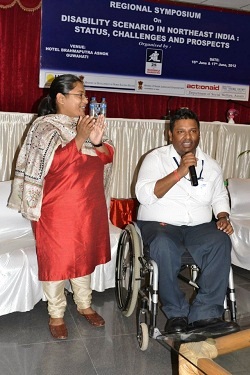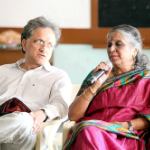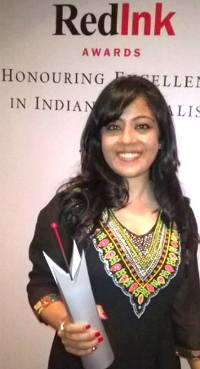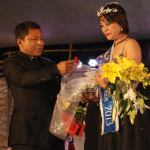Imphal 2009. Event: Annual meeting of the Network of Women in the Media
The Memory: Irom Sharmila. A pale poet's face framed by strong black curls... swathed in pink... eyes closed as if she did not even want to see the world which treated her so callously....her trance-like walk cradled in the arms of the Imas (mothers) who led her out of her hospital-prison and down the road to the tent where her supporters were on hunger strike.
Our group of women journalists had waited for hours on the kutcha road outside the non-descript building which housed India's most famous Satyagrahi... anxiously eyeing the army vehicles spitting out armed men very close to where we stood.... wondering if Sharmila would be released before curfew and if we would indeed get a glimpse of her before we were herded back to our hostel. What was our anxiety compared to the anxiety faced by our sisters in Imphal every single day?
Before that as we sat in solidarity inside the tent where the other Satyagrahis were on hunger strike a woman whispered to my Manipuri colleague: "We can only do this token fast every year. We have families and children to care for. Sharmila represents all of us. She is doing what none of us can do. She has given up her family, her life...we unfortunately have to trudge on."
And now as the twilight procession slowly wound its way to the tent I shifted my gaze from the tortured face of Sharmila to the Imas who held her. They had actually stripped naked in front of the Kangla Gate in the middle of Imphal to protest against the rape of a woman inside the fort by army personnel. They had held up a banner saying "Indian Army rape us". What could have moved these matronly middle aged women to this shocking act of defiance? How could the gentle looking Sharmila have fasted for more than a decade sustained only by the nutrition forcibly fed to her through her nose?
The answers I found later lay on the lips of the many women and men I talked to during that trip...ordinary people anxiously glancing over their shoulders and hastening through their chores in order to scurry back home before curfew to avoid those gun toting army men in their trucks....it lay in the tears of the young recently widowed mother who cradled her baby in her arms as she spoke to us of her husband who had been killed by a random bullet...in the eyes of the tea shop lady who had sent all her teen aged children away to South India so they could lead normal lives...in the story of the family whose young son had been branded a militant and shot.
And another memory: A memory which gives my Imphal trip a halo of joy. Colours and laughter. The colours of the beautiful clothes... the colours of the amazing women's market ...the joyful smiles on the faces of the dancers whom we joined....the smiles on the cute, chubby faces of the kids in uniform waving to us on their way to school.... the toothless smile of the old man sunning himself outside his mud hut... and the spontaneous laughter of the women journalists who hosted us with such joy and graciousness amidst all the turmoil and heartbreak.
This is how it was meant to be. This is the memory I cherish. Because this is the beautiful world my sisters from the North East want back permanently... not just in sporadic bursts.
My sisters from the Northeast I salute you.
Find us on facebook: facebook.com/TheThumbPrintMag







































